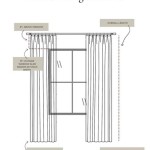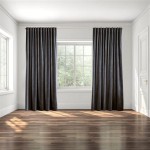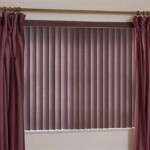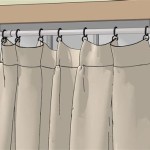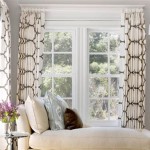Best Curtains To Keep Heat In: A Guide to Energy Efficiency
Maintaining a comfortable internal temperature during colder months requires effective insulation. While walls, roofs, and windows play crucial roles, curtains offer a practical and relatively inexpensive supplementary layer of thermal protection. Selecting the right curtains can significantly reduce heat loss, lower energy bills, and enhance the overall comfort of a living space. This article explores different types of curtains best suited for heat retention, focusing on their materials, construction, and key features that contribute to their insulating properties.
Understanding Heat Transfer and the Role of Curtains
Heat transfer occurs through three primary mechanisms: conduction, convection, and radiation. Conduction involves the transfer of heat through a material; convection refers to heat transfer via the movement of fluids (air); and radiation involves the transfer of heat through electromagnetic waves. Windows are notoriously poor insulators, allowing significant heat loss through all three mechanisms. Cold air in contact with the window's surface cools the surrounding air, creating a convective current that draws heat away from the room. Simultaneously, heat radiates outwards through the glass, and the window material itself conducts heat to the colder exterior.
Curtains act as a barrier, disrupting these heat transfer processes. They reduce convective currents by creating a still air pocket between the curtain and the window. This air pocket acts as an insulating buffer. Furthermore, denser, multi-layered curtains impede conductive heat loss. Certain materials, particularly those with a reflective backing, can also minimize radiative heat loss by reflecting infrared radiation back into the room.
Types of Curtains for Optimal Heat Retention
Several types of curtains are particularly effective at retaining heat. These curtains vary in their material composition, construction techniques, and overall insulating capabilities.
Thermal Curtains: Thermal curtains are specifically designed for energy efficiency. These curtains typically consist of multiple layers, often incorporating a dense inner layer, a reflective middle layer, and a decorative outer layer. The inner layer is responsible for blocking drafts and reducing convection. The reflective middle layer, often made of acrylic foam or metallized materials, reflects radiant heat back into the room. The outer layer provides aesthetic appeal and adds an additional layer of insulation.
The effectiveness of thermal curtains depends on the quality of the materials used and the tightness of the weave. Look for curtains with a high thread count and a dense construction. Backings made with multiple layers of acrylic suede offer superior insulation compared to thinner, single-layer backings. Some thermal curtains also incorporate a vapor barrier to prevent condensation buildup on the window.
Blackout Curtains: While primarily intended to block light, blackout curtains also offer significant thermal insulation. They are typically constructed from tightly woven, dense fabrics, often with multiple layers or a special coating that prevents light from passing through. This dense construction also makes them effective at reducing heat transfer.
Blackout curtains primarily reduce heat loss by blocking radiative heat transfer. The dense fabric absorbs and deflects infrared radiation, preventing it from escaping through the window. Additionally, the tightly woven fabric minimizes convective currents and provides some degree of conductive insulation.
The effectiveness of blackout curtains depends on the color and material used. Darker colors tend to absorb more heat, while lighter colors reflect more heat. However, for heat *retention* in winter, darker colors can be beneficial as they absorb heat from sunlight during the day and slowly release it into the room. Materials like fleece and thick polyester are particularly effective at blocking light and providing thermal insulation.
Insulated Curtains: Insulated curtains represent a broader category encompassing curtains specifically engineered for thermal performance. This category includes thermal curtains and blackout curtains, but it also encompasses curtains with features like quilted layers, fleece linings, or innovative materials designed for optimal insulation.
Quilted curtains feature multiple layers of fabric stitched together, creating pockets of air that act as insulation. Fleece-lined curtains provide a soft, warm layer that significantly reduces heat loss. Some insulated curtains also incorporate advanced materials like aerogel, a highly porous solid with exceptional insulating properties. However, aerogel-insulated curtains are typically more expensive and may require professional installation.
The effectiveness of insulated curtains depends heavily on the specific construction and materials used. Look for curtains with a high R-value, a measure of thermal resistance. A higher R-value indicates better insulation.
Layered Curtains: Layering curtains can significantly improve their insulating properties. Combining sheers, drapes, and valances creates multiple barriers against heat loss. The sheer layer provides privacy and diffuses light, while the drapes offer insulation and block light. The valance adds a decorative touch and further reduces convective currents at the top of the window.
The key to effective layering is to choose fabrics with different properties. For example, a sheer polyester layer can be combined with a thick velvet drape for optimal insulation and light control. Ensure that the layers are properly fitted and that they extend beyond the window frame to minimize drafts.
Key Considerations for Selecting Heat-Retaining Curtains
Choosing the right curtains for heat retention requires careful consideration of several factors, including material, construction, fit, and maintenance.
Material Selection: The material of the curtain plays a crucial role in its insulating properties. Dense, tightly woven fabrics like wool, velvet, fleece, and heavy polyester are generally more effective at blocking heat loss than lighter, more loosely woven fabrics like linen or cotton. Fabrics with a reflective backing, such as those found in thermal curtains, can further enhance heat retention.
Consider the climate and specific needs of the space when selecting materials. In colder climates, heavier, more insulating fabrics are preferable. In warmer climates, lighter-colored fabrics that reflect sunlight can help prevent overheating during the day.
Construction and Design: The construction of the curtain is equally important. Multi-layered curtains provide better insulation than single-layer curtains. Look for curtains with a dense inner layer, a reflective middle layer, and a decorative outer layer. Features like quilted layers, fleece linings, and vapor barriers can further enhance their performance.
The design of the curtain can also affect its insulating properties. Curtains with pleats or folds create pockets of air that act as insulation. Grommet-top curtains hang straight and allow less air to circulate between the curtain and the window, while pinch-pleat curtains create a more structured and insulating barrier.
Proper Fit and Installation: Even the most effective curtains will not perform optimally if they are not properly fitted and installed. The curtains should be wide enough to completely cover the window frame and extend beyond it on all sides. This will prevent drafts from entering around the edges of the curtain.
Hang the curtains as close to the window as possible to minimize the air gap between the curtain and the glass. Consider using a wraparound curtain rod, which curves back towards the wall, to further reduce drafts. Ensure that the curtains are hemmed properly to prevent them from dragging on the floor, which can create a tripping hazard and allow cold air to enter.
Maintenance and Care: Proper maintenance and care are essential for preserving the insulating properties of curtains. Dust and dirt can accumulate on the surface of the fabric, reducing its ability to block heat. Regularly vacuum or dust the curtains to remove any buildup. Follow the manufacturer's instructions for washing or dry cleaning.
Avoid exposing curtains to excessive sunlight, which can cause the fabric to fade and degrade over time. Consider using a protective spray to prevent staining and protect the fabric from moisture damage. With proper care, curtains can provide years of effective insulation and enhance the comfort of a living space.
Investing in high-quality, well-fitted curtains designed for heat retention is a practical and cost-effective way to improve energy efficiency, reduce heating costs, and create a more comfortable living environment. By understanding the different types of curtains available and considering the key factors outlined in this article, individuals can make informed decisions that optimize thermal performance and contribute to a more sustainable lifestyle.

The Best Curtains To Keep Heat Out Year Round Shade

The 7 Best Thermal Curtains In 2024 Curtain Reviews

The 7 Best Thermal Curtains In 2024 Curtain Reviews

4 Best Blinds And Curtains To Keep Heat In Winter

We Tested The Best Thermal Curtains See Our Favorites

Best Curtains To Keep Cold Out And Save Energy This Winter

The Best Curtains To Keep Heat Out Year Round Shade

We Tested The Best Thermal Curtains See Our Favorites

Beat The Heat With Breezy Summer Curtains For A Cooler Home

The Best Window Treatment Fabrics To That Keep Heat Out Or In

